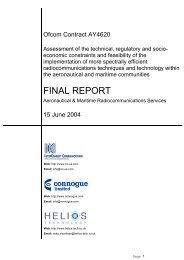Pay TV phase three document - Stakeholders - Ofcom
Pay TV phase three document - Stakeholders - Ofcom
Pay TV phase three document - Stakeholders - Ofcom
You also want an ePaper? Increase the reach of your titles
YUMPU automatically turns print PDFs into web optimized ePapers that Google loves.
<strong>Pay</strong> <strong>TV</strong> <strong>phase</strong> <strong>three</strong> <strong>document</strong> – non-confidential version<br />
3.43 These characteristics create a strong incentive to distribute content to as wide a set<br />
of consumers as possible. The incentive is particularly powerful in the case of<br />
advertising-funded free-to-air broadcasting, where revenues increase with reach.<br />
3.44 The incentives are somewhat more complex for subscription-funded pay <strong>TV</strong><br />
broadcasting. This is because subscription revenues are also likely to increase with<br />
reach, but only if some form of price discrimination is adopted, which allows content<br />
to be distributed to additional consumers, whose marginal willingness to pay is lower<br />
than the average willingness to pay of existing consumers.<br />
3.45 Price discrimination in these circumstances can have beneficial effects for both<br />
producers and consumers, since it can be an effective way of recovering the high<br />
fixed costs of generating content in a way that enables more consumers to take a<br />
product. Price discrimination is widespread in the pay <strong>TV</strong> sector, though it operates<br />
differently in the commercial and residential parts of the sector.<br />
3.46 In the commercial sector, there is explicit price discrimination, in that different<br />
customers are charged different prices for access to Sky’s Sports channels. In the<br />
case of ‘pubs and clubs’, for example, prices are based on the rateable value of<br />
premises, using this as a proxy for the value associated with distributing content to<br />
specific premises. Hotels, betting shops and offices all have their own specific pricing<br />
structures.<br />
3.47 In the residential sector, all customers are charged the same price for the same<br />
channels, so there is no explicit price discrimination. Instead, there is a form of<br />
implicit price discrimination, which relies on the fact that retailers are likely to attract<br />
more consumers by retailing bundles which contain a variety of channels containing<br />
different types of content. In such circumstances a number of consumers may be<br />
willing to pay the same aggregate price for a bundle, despite each attaching different<br />
values to different elements of the bundle.<br />
3.48 We have previously set out an illustrative example of this effect, which we will repeat<br />
here. Consumer A values a sports channel at £10 and a movies channel at £2, and<br />
consumer B values a movies channel at £10 and a sports channel at £2. A company<br />
selling each channel individually would set the prices at £10; both consumers would<br />
buy their most preferred channel, giving total revenue of £20. However, if the<br />
company sets the price of a bundle of the two channels at £12, both consumers will<br />
take the bundle, yielding revenue of £24.<br />
3.49 Specific examples of retail bundling in pay <strong>TV</strong> include:<br />
� Basic channels are commonly sold in bundles rather than individually. Sky retails<br />
basic channels in a number of genre-specific entertainment packs, which can in<br />
turn be aggregated into bundles containing multiple packs. Virgin Media retails<br />
basic channels in <strong>three</strong> tiered packages, ‘M’, ‘L’ and ‘XL’, containing an<br />
increasing number of channels (~45, ~100 and ~165 respectively).<br />
� Premium channels are commonly sold in genre specific bundles (‘Sky Sports<br />
Mix’, ‘Sky Movies Mix’) as well as in mixed bundles containing both sports and<br />
movies.<br />
� Premium channels are also commonly sold as part of a bundle with basic<br />
channels, via a mechanism known as ‘buy-through’. This requires consumers to<br />
buy a basic package before they can buy a premium package. All of Sky’s<br />
47
















